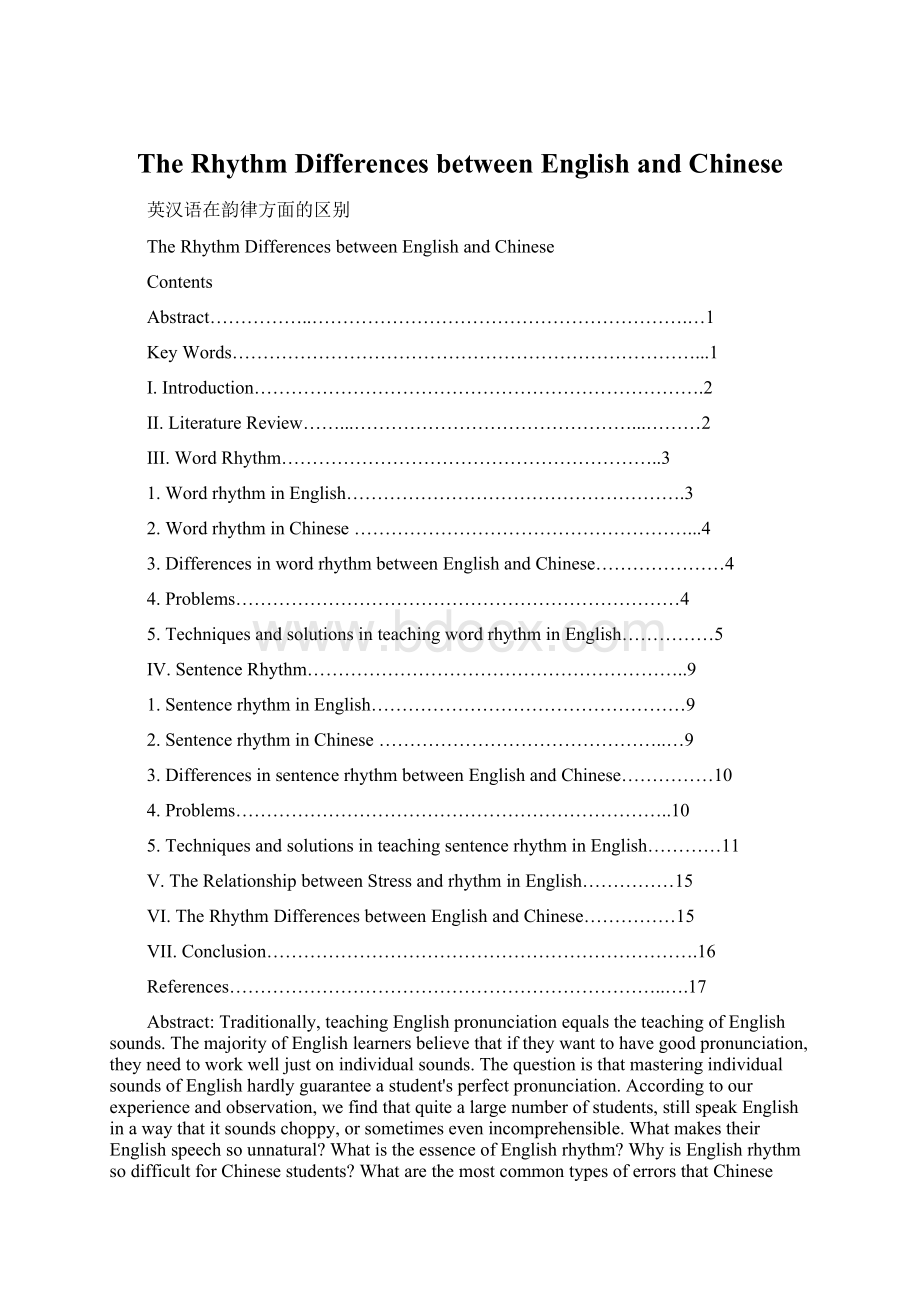The Rhythm Differences between English and Chinese.docx
《The Rhythm Differences between English and Chinese.docx》由会员分享,可在线阅读,更多相关《The Rhythm Differences between English and Chinese.docx(15页珍藏版)》请在冰豆网上搜索。

TheRhythmDifferencesbetweenEnglishandChinese
英汉语在韵律方面的区别
TheRhythmDifferencesbetweenEnglishandChinese
Contents
Abstract……………..…………………………………………………….…1
KeyWords…………………………………………………………………...1
I.Introduction……………………………………………………………….2
II.LiteratureReview……...………………………………………...………2
III.WordRhythm……………………………………………………..3
1.WordrhythminEnglish……………………………………………….3
2.WordrhythminChinese………………………………………………...4
3.DifferencesinwordrhythmbetweenEnglishandChinese…………………4
4.Problems………………………………………………………………4
5.TechniquesandsolutionsinteachingwordrhythminEnglish……………5
IV.SentenceRhythm……………………………………………………..9
1.SentencerhythminEnglish……………………………………………9
2.SentencerhythminChinese………………………………………..…9
3.DifferencesinsentencerhythmbetweenEnglishandChinese……………10
4.Problems……………………………………………………………..10
5.TechniquesandsolutionsinteachingsentencerhythminEnglish…………11
V.TheRelationshipbetweenStressandrhythminEnglish……………15
VI.TheRhythmDifferencesbetweenEnglishandChinese……………15
VII.Conclusion…………………………………………………………….16
References……………………………………………………………..….17
Abstract:
Traditionally,teachingEnglishpronunciationequalstheteachingofEnglishsounds.ThemajorityofEnglishlearnersbelievethatiftheywanttohavegoodpronunciation,theyneedtoworkwelljustonindividualsounds.ThequestionisthatmasteringindividualsoundsofEnglishhardlyguaranteeastudent'sperfectpronunciation.Accordingtoourexperienceandobservation,wefindthatquitealargenumberofstudents,stillspeakEnglishinawaythatitsoundschoppy,orsometimesevenincomprehensible.WhatmakestheirEnglishspeechsounnatural?
WhatistheessenceofEnglishrhythm?
WhyisEnglishrhythmsodifficultforChinesestudents?
WhatarethemostcommontypesoferrorsthatChinesestudentsmakeinEnglishrhythmwhenspeaking?
WhichtechniquesandsolutionsareusefulinthelearningandteachingofEnglishrhythm?
Inaddressingthequestionsposedabove,thispaperwillattempttoexplorethefeaturesofEnglishrhythmandsuggestanumberoftechniquesforhelpingstudentsspeakEnglishwithgoodrhythm.Thefocusofthediscussionwillbeon:
(1)wordrhythminEnglishandChinese;
(2)sentencerhythminEnglishandChinese;(3)thedifferencesbetweenEnglishrhythmandChineserhythm;(4)avarietyofpracticalkinesthetic,visual,andauralteachingsolutionsandactivitiesarepresentedtosolvetheproblemsatthesametime.
Keywords:
stresses;Englishrhythm;Chineserhythm;similaritiesanddifferences
摘要:
从传统角度上看,教英语的发音等于对英语语音的教学。
许多语言学习者认为,如果他们想要语音发音好,他们只需要发好单个的语言音素。
但问题在于,掌握英语的个别的音素就能说一个学生的发音是好的吗?
根据我们的经验和观察,许多学生虽然能够发好单个音素,但并不能说一口地道的英语,有时甚至让听者难以理解。
出现这种现象的原因是什么呢?
英语节奏是什么?
为什么英语节奏对中国学生就如此困难?
中国学生在英语节奏上所犯的最常见的错误类型有那些?
在教授英语节奏的过程中是否有对学习和教学有实用价值的技巧和解决办法?
为了寻求上述问题的答案,作者将从分析、总结英语发音节奏的主要特征、规律入手来以探寻英、汉语言的韵律异同,目的是更好得使学生能在了解并掌握英语语言韵律的基础上说一口地道、流利的英语。
本文讨论的主要内容:
(1)英、汉语言单词的节奏;
(2)英、汉语言句子的节奏;(3)英、汉语言节奏的差异;(4)与动觉,视觉和听觉有关的实际、有效的的解决方法。
关键词:
重音;英语韵律;汉语韵律;异同与差异
I.Introduction
BasedonourpresentstudywefindthatalthoughmostChinesestudentscanspeakEnglishwordscorrectlyandclearly,however,theywillsayEnglishsentenceswordbywordorphrasebyphraseinroughlyequallengthoftimeandloudness.Mostofthemcanhardlyreadunstressedsyllablesinacorrectway,whicheitherinspeechorinconversation.GenerallytheyspeakEnglishwithachangelessaccentwhichsoundschoppyandincomprehensive.ThereasonofthisphenomenoncanbeduetothefactthattheyhavenoideaaboutthedifferencesbetweenEnglishrhythmandChineseone.
Nowadaysquiteanumberofresearchershavestudiedrhythminthediscoursallevel,especiallyinessaysandpoetry.However,rhythmdoesexistinsmallerdomainsinbothEnglishandChinese.ChineserhythmexhibitsmuchthesamenatureasthatofEnglishrhythm,althoughdifferencesbetweenthemdoexist.Ourtaskistofindoutthesimilaritiesaswellasthedifferencestoexplorethesolutionstotheproblems.Inordertoknowtherhythmicpropertiesofbothlanguages,weshouldsearchlargenumbersoflanguagedataandtrytofindthemechanismwhichmakestherhythmofalanguage.Ihavestudiedbothlanguagesfromanobjectiveandscientificpointsofviewanddiscovered,althoughthetwolanguagesdiffergreatlyonthesurface,yettheyarebasicallythesameinthedeepstructure.
Inthepresentthesis,IwillcompareEnglishrhythmwithSCrhythmunderthediscoursallevel.MytaskistointroducethelateststudyonEnglishrhythmandmakeacomparisonandcontrastbetweenEnglishrhythmswithChineseones.
II.LiteratureReview
Whatisrhythm?
BeforewediscusstheEnglishandChineserhythm,wemayhavetoexplainwhatrhythmis.Dauersaysintheunit“Rhythm”fromhisbookAccurateEnglish(1993):
whenwespeaknaturally,wordsarepartsofphrasesandlongerSentences.Whatwehearisasequenceofsyllables,likenotesinmusic.Thetimerelationshipsamongsyllablesmakeuptherhythmoflanguage.(p.83)
Rhythm,actually,istimingpatternsamongsyllables,which,maynotbethesameinalllanguages.Thereare,particularly,twooppositetypesofrhythminlanguages:
stress-timedandsyllable-timed.AccordingtoMackay(1985),stress-timedrhythmisdeterminedbystressedsyllables,whichoccuratregularintervalsoftime,withanunevenandchangingnumbersofunstressedsyllablesbetweenthem;syllable-timedrhythmisbasedonthetotalnumberofsyllablessinceeachsyllabletakesapproximatelythesameamountoftime.English,withanalternationofstressedandunstressedsyllables,belongstothesecondtype,whileChinese,withnearlyequalweightandtimeinallsyllables,issyllable-timed.Thesetwolanguages,therefore,varygreatlyinrhythm.Holliday(2000)alsoclassifiesrhythmintotwotypes:
1.SyllabicRhythm(SyllabicTiming)andPedalingRhythm.Thefirstindicatesthetempodependsonthesyllablesothatallsyllablestendtoberoughlythesamelength,forwhichhecitesJapaneseandFrenchasgoodexamples.Thelatterone,PedalingRhythm(FootTiming)indicatestempodependsonthefoot,sothatallfeettendtoberoughlythesamelengthoftime.Thatis,inanutterance,ifafootisofthreeorfoursyllables,itwillbearticulatedwiththesamedurationasafootismadeupofonlyonesyllable.HecitesEnglishasanoticeableexampleofthistype.DavidAbercrombieclaimsrhythmintoanothertwotypes,too:
1)syllable-timedrhythmimpliestheperiodicrecurrenceofmovementsuppliedbythesyllable-producing,theprocessofwhichisthechest-pluses,withthesyllablesrecurringatequalintervalsoftime–theyareisochronous.French,Spanish,YorubaandHindihavesuchasortofrhythm.2)stress-timedrhythmimpliesperiodicrecurrenceofmovementsuppliedbythestress-producing,andprocessofwhichisthestress–pluses,andhencethestressedsyllablesareisochronous.English,Russian,Arabiccanillustratethismodebest.
WhetherChinesebelongstoasyllable-timedlanguageorstress-timedlanguagehasbeenstillunderdiscussion.SomewriterslikeProfessorT.K.Kweisaysitbelongssyllable-timedlanguage.Otherholdthejustoppositepointsofviewwiththem.Mr.YeShengtaocriticizedseverelytheintolerablesyllable-timedrhythmusedinteachingschoolchildrentheChineselanguage.ThepresentauthorholdsidenticalviewswithMr.Yeshengtao.NumerousexamplesfromTVserialsandradioplaysshowthatnoneofthecharactersspeakChineseinasyllable-timedrhythm.ButCantonesespeakersofPutonghuafromHongkongandGuangdongProvincearepossibleexceptions.
III.WordRhythminEnglish
1.WordrhythminEnglish
Englishwordsmaybecomposedofoneormoresyllables.Inwordsoftwoormoresyllables,onesyllable(stressedsyllable)isstrongerthantheothers(unstressedsyllable(s))intheoneandsameword.Astressedsyllableislouder,longer,clearer,andhigherinpitchthanunstressedsyllables.Thus,thecombinationofstressedandunstressedsyllableshelpstocreatethewordrhythminEnglish,whichdisplaysanalternativechangeinstrength,length,andpitch.
TheimportanceofsyllablestresshasbeenexplainedbyGilbert(1994):
“thisisbecauseEnglishspeakersappeartostorevocabularywithstresspatterns,soastressmistakecanthrowaconversationofftrack,especiallyifthespeaker’scontrolofEnglishvowelsoundsisuncertain”.Therefore,themorefrequentlyspeakersmisusestress,themoreeffortlistenershavetomaketounderstandwhatthespeakersay.
2.WordsrhythminChinese
Chinese,atonelanguagewithfourkindsoftonepatterns,withwhichstressineachChinesesyllableisequallystrong,sotheChinesestudentsgenerallygiveeachChinesesyllablealmostthesamestrength,length,andpitchwhenspeaking.ThedifferencesofthefourtonesmakeChinesewordssoundchangingregularly,thatis,thedifferenttonesofChinesewordsmaketheChinesewordrhythm.
3.DifferencesinwordrhythmbetweenEnglishandChinese
HavingaclearideaofwordstresspatternofEnglishisveryimportanttoourstudents.InEnglish,therearethreestresspatterns,primarystress,secondarystressandtheunstressedorzerostress.Differentkindsofsyllableshavedifferentstrength,length,andpitch,whilethestressesofChinesesyllableshavealmostthesamestrength,length,andpitch.
4.Commonproblemsinwordrhythm
NotrealizingtheimportanceofsyllablestressinEnglish,manyChinesestudentstendtoignorestresspatternsofEnglishwords.Whenreadingorspeakingtheywillputstressinanyoneofthesyllablesinawordrandomlyandthismaycausemisunderstandingproblems.Forexample:
“ThemovieIsawyesterdaywasTERrific”,saidastudent.Intheword“terrific,”heputthest